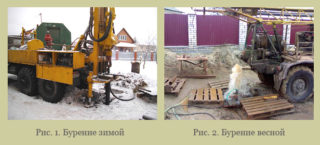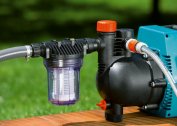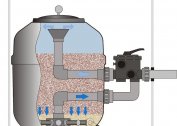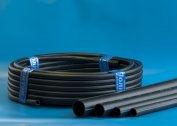In a country house or in a summer cottage, you cannot do without enough water; it is necessary both for household needs and for ensuring timely watering of plants. The most modern and convenient to use is the arrangement on the well site, which will uninterruptedly provide the house with water.
Features winter work and benefits
 Well drilling activities in the cold season have many advantages and are always positively evaluated by professionals. Despite the fact that in some areas of Russia in winter the soil freezes to a depth of 2 meters, this can not interfere with the work, because the water well, in which there is a layer of drinking water, lies at a depth of 5-10 meters.
Well drilling activities in the cold season have many advantages and are always positively evaluated by professionals. Despite the fact that in some areas of Russia in winter the soil freezes to a depth of 2 meters, this can not interfere with the work, because the water well, in which there is a layer of drinking water, lies at a depth of 5-10 meters.
What are the benefits:
- frozen ground is easy to drill, a small amount of groundwater allows the procedure to be carried out as efficiently as possible;
- the absence of seasonal landings on the land does not interfere with the installation of equipment and work;
- snow cover helps the technician to get into areas that in the spring are flooded with water for a long time;
- winter drilling costs are lower due to a seasonal drop in demand.
When to drill
Most often, water wells are drilled in the warm season. This is primarily due to the convenience for the owner of the site, but much less effective compared to winter drilling.
Winter drilling is carried out in the coldest months, and this is December and January. At the same time, professionals recommend that the air temperature does not fall below -20 Celsius.
Disadvantages of winter well drilling
 Although winter work has a number of advantages, however, drilling in winter has a number of disadvantages that must be taken into account in advance.
Although winter work has a number of advantages, however, drilling in winter has a number of disadvantages that must be taken into account in advance.
- In the case of severe freezing of the soil, the time for the planned work can greatly increase. The speed of work in frozen ground is much lower than in the warm season.
- Water frozen in the well may interfere with its operation even before commissioning. To avoid this, it is necessary to take measures in advance to warm both the well itself and the water pipes leading to residential and utility buildings.
For insulation, most often resort to the use of special multilayer communications and covers, the so-called segmented heaters. Several layers of polystyrene foam or polyethylene material tightly fit the pipe, not allowing it to burst even if the soil is completely frozen. It is important to note that hydro and thermal insulation of water pipes must be carried out regardless of the drilling season. A system installed in summer without proper insulation and insulation can lead to rupture in winter due to freezing of water in it.
Obviously, drilling a well in the area is necessary. However, before starting the design and execution of work, it is worthwhile to carefully study all the pros and cons of the winter drilling option, as well as purchase the necessary heat-insulating material.


